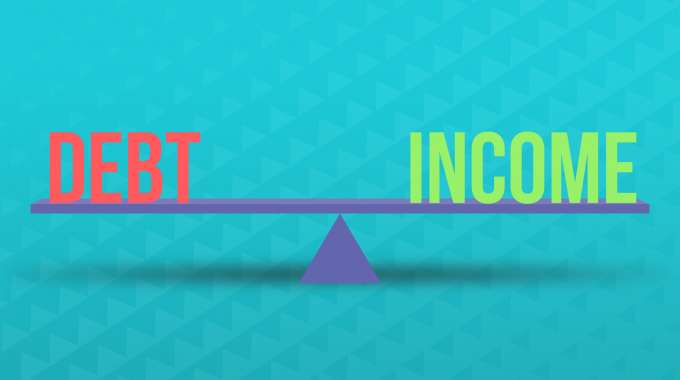In fact, Canada was named “world leader” in debt as recently as 2018. That’s doesn’t exactly give you chills of patriotic pride.
So, what’s creating this debt bubble? Well, basically, most Canadians have a high debt-to-income ratio, pushing up the national average.
Let’s discuss what a debt-to-income ratio means, why it matters, and how you can do a pulse check on your debt-to-income levels.
What is Debt-To-Income?
Debt-to-income is a personal finance measurement that compares your gross household income against the debts you owe. Gross income is the money you take home before taxes and other non-discretionary expenses like EI and CPP contributions.
The debt-to-income ratio is measured by simply adding up all your recurring monthly debt obligations (rent/mortgage, auto loans, credit card payments, etc.) and dividing it by your gross monthly income before taxes and deductions.
In June 2020, the debt-to-income ratio in Canada was reported to be 176.9%, meaning we owe $1.769 for every dollar of disposable income. That’s slightly lower than our record peak of $1.77 in 2017. It’s down, but nothing to brag about.
Why it’s Important to Understand Debt-To-Income?
The debt-to-income percentage gives you a compass to gauge where you stand on income versus debt and also makes you think about the state of your personal finances. The general consensus regarding debt is you shouldn’t have too much of it. High debt levels make you vulnerable to financial shocks, which can be anything from a job loss to a marital breakdown.
If your personal debt-to-income is above the national average, don’t feel bad because you’re not alone. But that doesn’t mean you shouldn’t try and bring down your debt-to-income if possible. You want to be more resilient to unexpected shocks. If your debt is stretching you financially every month, any kind of disruption is going to cause extreme stress.
Lastly, it’s important to know your debt-to-income ratio because this is something lenders look at when deciding what kind of mortgage or line of credit you qualify for. More to come about that.
What Kind of Debt-To-Income is Required to Get Approved for a Mortgage?
When applying for a mortgage, lenders will use two main ratios – Gross Debt Service (GDS) and Total Debt Service (TDS) – to decide how much, if anything, they can loan you. They are similar to debt-to-income measurements.
Gross Debt Service is the percentage of your monthly household income that covers your housing costs. It cannot exceed 35%.
Total Debt Service is the percentage of your monthly household income that covers your housing costs and any other debts. It cannot exceed 42%.
It’s Easy to Calculate Your Debt-To-Income Ratio
There are calculators to help you figure out your debt to income ratio, but it’s also pretty easy to do yourself. Here’s an easy example:
- $1500 for rent
- $300 for your car payments
- $120 on a credit card
- $200 for all other bills
That equals $2120 in monthly obligations against, say, a gross income of $5000. Your debt-to-income percentage would be 42%. ($2,120 / $5,000 = 0.42).
Math equations giving traumatic flashbacks to high school? That’s okay because they are plenty of handy debt-to-income calculators at your disposal.
What’s Considered a Good DTI?
While debt is usually viewed in a negative light, it must be said that times have changed in our attitudes towards debt. As we watch governments spend mind-boggling amounts of money and carry billion in debt each year, it’s hard not to view debt as normalized.
Even the Bank of Canada encourages debt consumption with economy-sparking reductions on the interest rate. Debt, especially mortgages, is seen as a way to spread out your spending over a lifetime.
That being said, you shouldn’t get too comfortable with debt. You don’t want to spend your adult life sweating out whether you are going to make it to the next paycheque. The key is to find a healthy balance.
Here’s a good debt-to-income percentage according to debt.ca.
- Good: 36% or less
- Manageable: 37% to 42%
- Cause for concern: 43% to 49%
- Dangerous: 50% or more
Need Help Wrestling Your Debt?
If your debt-to-income ratio is running high, debt consolidation could be a way to get your debts under control. Spring Financial works with Canadians of all credit backgrounds to consolidate debt, build credit, and get access to the loan products they need. Talk to us today to discuss how we can help you.








